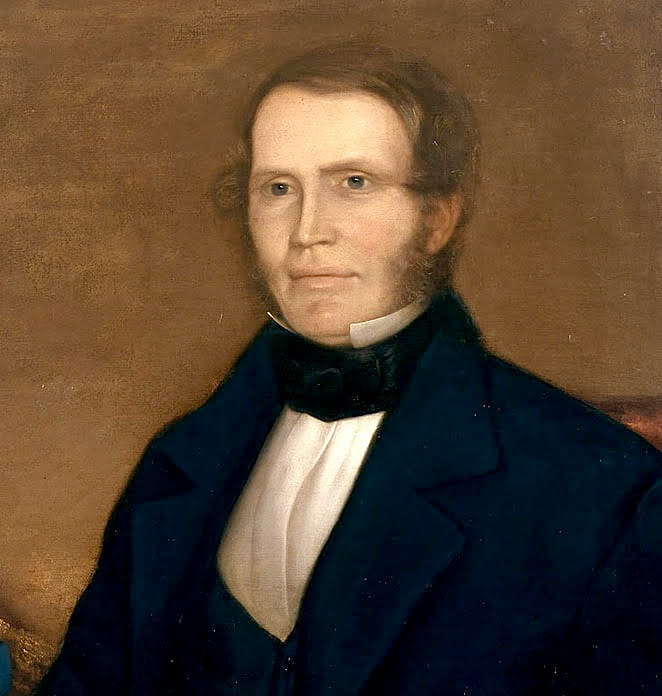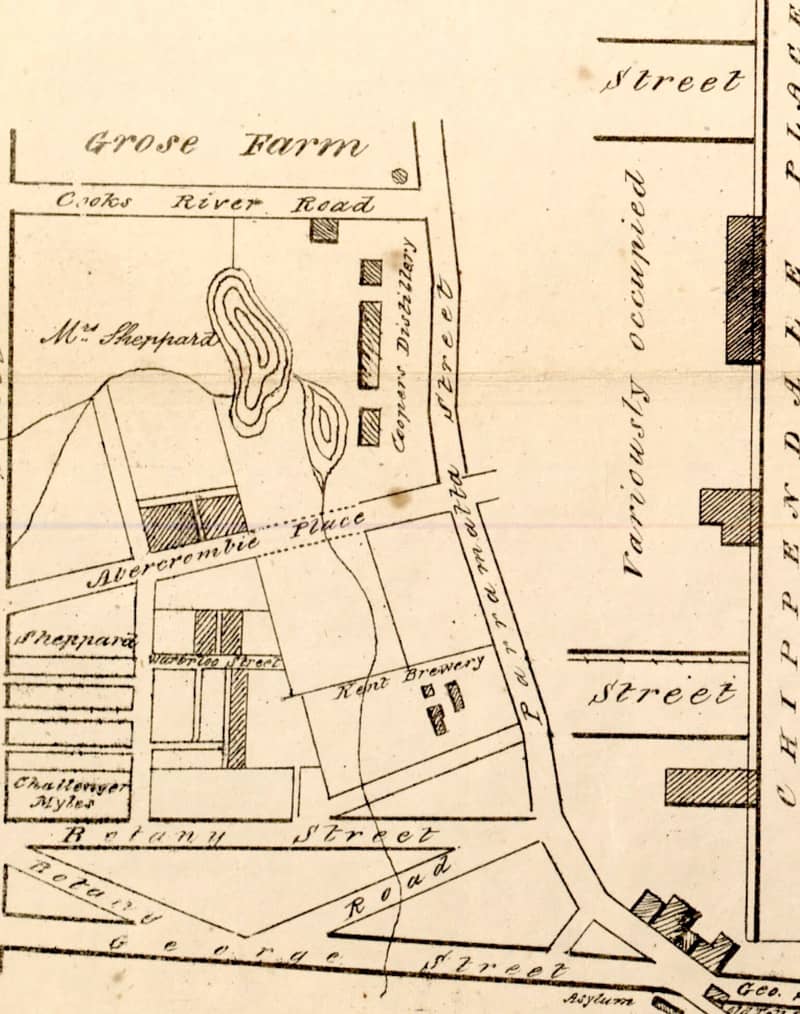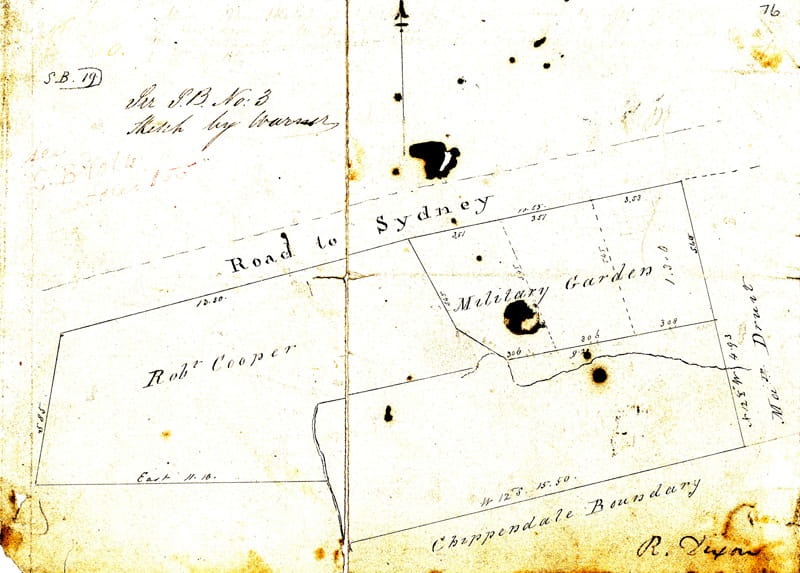
During the 1840s when Henry Smithers Hayes managed the Brisbane Steam Flour Mill he gave his address as ‘Blackwattle Swamp’. Before land reclamation was finally completed in 1880, the muddy headwaters of Blackwattle Bay reached about as far as today’s Parramatta Rd. In a real estate quasi-pastoral spin, some auctioneers named the area ‘Blackwattle Swamp Brook’. The reality was insalubrious. City councillors referred to the main drain as a cesspool, not flushed for months, with thousands living within range of the ‘Blackwattle malaria’. Of particular concern were the slaughter houses which created ‘terrible effluvia’.
The flourmill was part of a complex developed by wealthy ex-convict Robert Cooper on Parramatta St, roughly opposite the stretch of land where St Barnabas Church now stands. Named for the NSW Governor, the main buildings were the Brisbane Distillery and Flour Mill, together with a Sugar House, a warehouse called the Pantechnicon and substantial dwellings including Brisbane Cottage. Water for the operations came from three streams channelled into a massive 183m2 dam, its depth ranging from three to nine metres and the overflow crossing Parramatta St. What was dug out was no doubt used as building material. Robert Jones, a carpenter, was one of the dam’s first victims. In 1828 he drowned after going in to bathe and slipping into a hole.
Cooper’s operations were already well advanced in 1824 when the Surveyor-General returned from Moreton Bay to discover that they were on the wrong piece of land. Advised that he couldn’t build his gin distillery at Glebe because it was owned by the Church, Cooper had been offered a parcel west of the main watercourse. A pencil sketch was made of the location. But Cooper built to the east, within the Sydney boundary. Suddenly finding that the acreage was valuable as a public water supply source, the Crown prosecuted, but the jury found for the defendant.
Sydney’s flour was produced by a handful of privately owned mills and the Carter’s Barracks treadmill (near today’s Central Station) where convicts inside a cage trod the everlasting staircase to turn heavy grindstones. Cooper’s mill produced flour, bran and pollard (a by-product fed to fowls) from grain carted from Liverpool, Camden and Campbelltown. A number of millers (including Barker and Hallen whose major enterprise was at Darling Harbour) occupied the Brisbane Steam Mill before Henry Smithers Hayes took over its management in 1841.
Henry Smithers Hayes was born in Cork, Ireland, the son of a miller. In 1828 he married Mary Smithers (1809-99), the daughter of a Customs officer. In October 1840 they disembarked in Sydney from the Elphinstone, a bounty emigrant ship carrying agriculturalists arriving just in time for the summer harvest. The couple brought their seven children; they were to have at least six more.
From July 1841 newspaper ads began appearing for the Brisbane Steam Flour Mill store in The Rocks. Apart from flour, the anonymous proprietor promised to sell bread made solely from local wheat, with no ‘admixture of sour American flour’, at a penny a loaf cheaper than any competitor. After rival bakers demanded his name, he revealed himself as Henry Smithers Hayes and made further pledges to ‘grind and dress wheat into flour in a very superior manner’.
Hayes found himself in court a number of times. On arrival in the colony he had entered a short-lived informal partnership with another miller and dairyman. When the two split, they argued about dividing their few assets: some cows, poultry and muskets. The dispute ended in 1842 with a court finding against Hayes who also had to pay costs. The same year he was acquitted of assault and battery on Sarah Kirker who worked in his bakery while her husband delivered bread. Kirker claimed that she was seized by the hair and rough handled by Hayes who was attempting to evict the couple from a room they rented from him. In 1843 Hayes sued Thomas Lyons for £10,000 slander after the market gardener called Hayes a swindler and placed newspaper ads warning people not to lend him money. Lyons had mortgaged part of his Chippendale acreage to Hayes on condition that he be reimbursed £110 p.a. and that rent Hayes was receiving from his houses be paid into a bank account. As Hayes hadn’t fulfilled the bargain, Lyons stated that the contract was null and void. The jury awarded Hayes damages of one farthing.
In 1843 Robert Fitzpatrick was ordered back to the Hayes’ household after absconding, a breach of the Hired Servants’ Act. One of their maids, Mary Ann Mills, an immigrant from Yorkshire, also took off. She was recaptured in Sydney but not handed over to the local police. Instead, the arresting sergeant took her by steamer back to his watch house at Parramatta so he could claim the ten shillings reward. In 1844 another runaway Maria Ryan was sentenced to two months third class in the Female Factory.

Hayes made a few enemies close to home when giving evidence on a Tariff Bill before the Legislative Council in 1845. If the duty on spirits were lowered, he suggested, the sale of beer would be affected. In support of Inspector Maxwell’s assertion that the Brisbane Distillery bond stores were insecure and prey to thieves, Hayes stated that an illegal pipe in the distillery siphoned off spirits into buckets which were then carried through the yard of the mill towards Brisbane Cottage. William Robert Newman, the cottage’s tenant, vigorously denied the implication. And Robert Cooper prior to transportation had history as a smuggler.
In another appearance before the Legislative Council, Hayes accused Blackwattle Swamp slaughter-houses of drying out the creek in summer, forcing him to pump used water back into his dam. In 1849 Alexander Cooper and Hayes each offered a £20 reward after an abutment between the dam’s upper and lower levels was cut. Cooper claimed that all the water then went to the mill. Hayes asserted that the water he received was putrid and stagnant.
Despite some unease about Hayes’ probity, he was nominated by the Mutual Protection Association as councillor for Cook Ward in 1844 City Council elections. (Hayes stood and received the lowest vote of four candidates.) He commissioned a portrait in oils and joined the thousands of gentlemen celebrating the Queen’s Birthday at the new Government House. To all appearances he was smugly prosperous.
All this changed in November 1845 when Hayes was declared insolvent. Creditors began lining up, including the Union Bank, auctioneer G A Lloyd, slum landlord and 1847 City Mayor Thomas Broughton, ironmonger Thomas Woolley, and Charles Dunn owed for £15 worth of his ‘Incomparable Ginger Pop’. Amounts ranged from 19 shillings to £100. Robert Cooper and Hayes made claims and counter-claims for money. Meetings dragged on until 1849 when, debts exceeding assets by £501, Hayes was declared bankrupt. He was allowed to keep his clothing and bedding, but a final settlement was not made.
In February 1850 the 17-acre Blackwattle Swamp Estate extending from the Kent Brewery to the road to Newtown was auctioned for £9,500. Its structures included not only the distillery, mill, dam, pantechnicon, sugar house and Brisbane Cottage, but 22 stone, 12 brick and 57 substandard weatherboard houses. The Brisbane Steam Flour Mill was by now being rented by James Pemell.
Meanwhile Hayes was making preparations to quit the colony. He booked a passage for himself, his pregnant wife, three daughters and seven sons on the Harmony bound for California, no doubt hoping to take advantage of business opportunities offered by the goldrush. Arrested on the ship and brought before the Chief Justice, he was discharged on the grounds that his assets were less than £100. The family made the trip – George Francisco was born in July 1850 – but were back at Blackwattle Swamp by the following May.
For a time, Hayes lived on Elizabeth St near Lyons Terrace, keeping poultry but losing another hired servant (Charles Smith who was gaoled for a month), before he decided to set up milling operations in the country, moving through Yass, Tumut and Goulburn. In 1864 Hayes and his wife were held up near Gundagai and relieved of some money by bushrangers Ben Hall, John Gilbert and John Dunn. In 1866 the miller was declared insolvent at Bathurst.

In 1873 Hayes was engaged by the Grenfell Steam Flour & Saw Mill Company to build works to process local grain and timber. He was to pay rent to live on the premises. In October 1874, after the company manager was thrown from a horse and killed, Hayes went to his office and removed the company books and money vouchers. He was tried for larceny, but acquitted. The next month a trustee of the mill company called on Hayes, advising him that because he had not paid rent, he had broken the contract and was to leave the premises. Hayes refused to vacate but was ordered to do so by a court order. In 1875 he was sued in the Small Debts Court.
Henry Smithers Hayes died in 1881 at a daughter’s house near Forbes, a town where other children settled and where his widow passed away 18 years later. The sons followed their father into the milling industry, some into bankruptcy, and at least one into court.
George Francisco Hayes, who received the insurance payout after the Gundagai flour mill he leased and occupied burnt down, was arrested in 1881 for passing a valueless cheque. A miller at Yass, he was declared insolvent in 1887. Most successful was James who had arrived in Sydney as a nine-year-old. He was elected MLA for Hume 1885-97 and for Murray until 1904, and was Minister for Lands in the See Government. James stipulated in his will that his sons carry on Hayes Bros Mills at Albury.
It is likely that Smithers St in Chippendale, named by 1842, has links with the patriarch. James Pemell’s Brisbane Steam Flour Mill was destroyed by fire in 1870.
Lyn Collingwood
Historian
Sources: NSW registry of births, deaths, marriages; NSW State Records; Trove website









One comment. Please add yours.
Thanks Lynne. He’s my GGGrandfather through James. I knew little of his story.